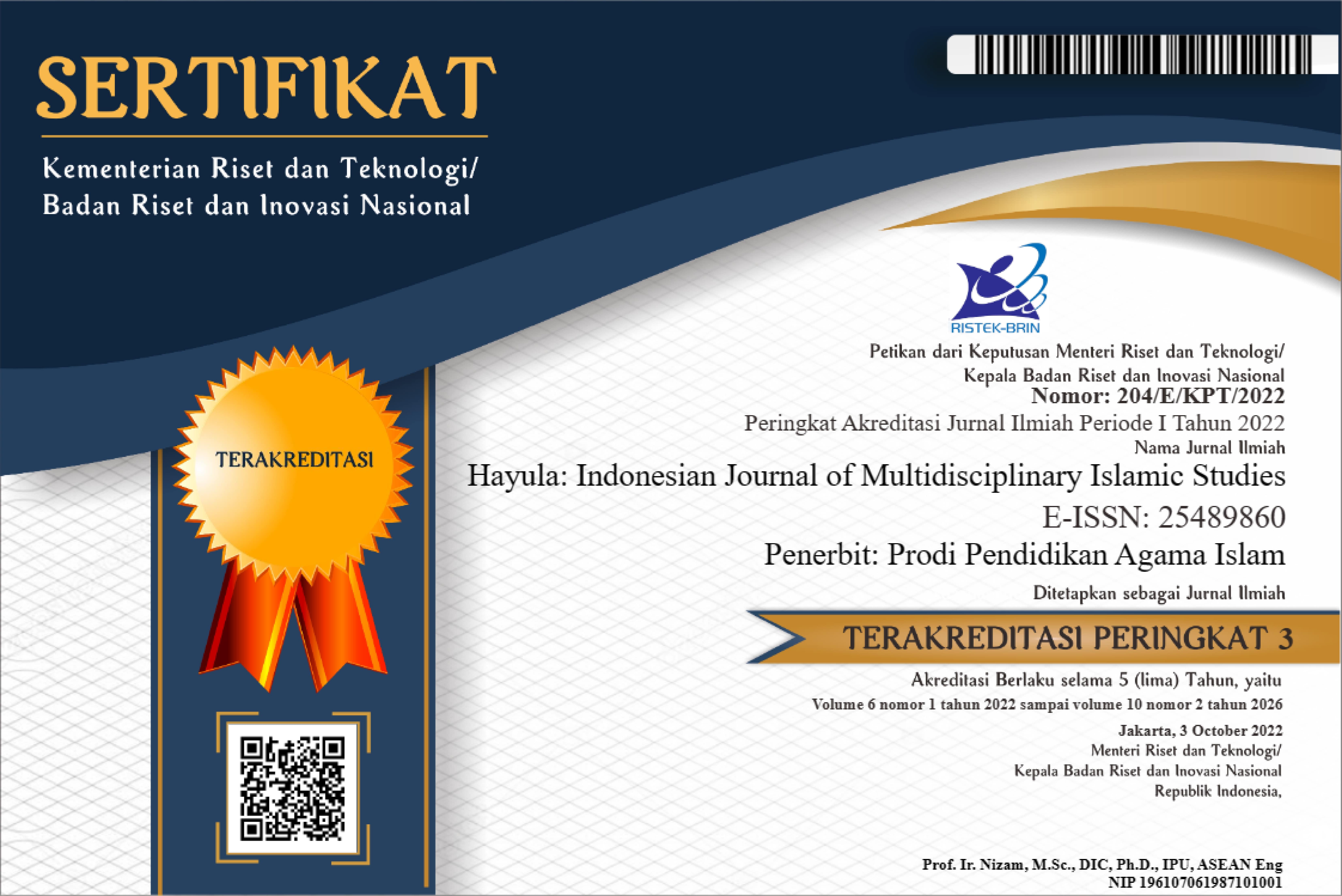INNOVATION IN ISLAMIC EDUCATION
DOI:
https://doi.org/10.21009/hayula.002.2.02Keywords:
Innovation, Islamic education, European education, Advanced technology, Education system, Educational curriculum, Globalization.Abstract
The approach to religious education had been shaped by historical, cultural, social, and political reasons, however, both the inherited secular education system and traditional religious education system, as standalone, can never bring development to the society. Hence, the religious education must be combined with secular education and the innovative approaches in education evolve continuously to uphold the pedagogy, learning approaches and facilities even in the current context to sustain, endure to be relevant and culturally resilient with the contemporary scientific and advanced technology. The process of education evolved in many countries, radically changed from traditional madrasah to localized vernacular schools, and then on to European education. The educational curriculum should kindle the learning process by systematic observation, quantitative reasoning and scientific expressions. The learning tools should engage students with the creation through observation, pictorial and descriptive records, exploration, articulation, and communication with fellow students. This paper analysis a combination of both structural and cultural orientations on identified needs leading to facilitations in learning environment, implementing knowledge to practice, and finally evaluated for the fulfillment or gap identification, for furthering the learning or development inputs towards constructive utilization and growth.
References
Mohd Nor, M. R., & Bahroni, I. (2011). Iqbal’s Philosophy on Islamic Education: A Historical Perspective, GJAT. Vol 1.
Niyozov, S., & Memon, N. (2011). Islamic Education and Islamization: Evolution of Themes, Continuities and New Directions. Journal of Muslim Minority Affairs, 5-30.
Silvestr, S., & Mayall , J. (2015). The Role of Religion in Conflict and Peace building. Retrieved from https://www.britac.ac.uk/sites/default/files/Role-of-religion-in-conflict-peacebuilding_0.pdf. .
Abd-Allah, U. F. (2014). Innovation and creativity in Islam. Retrieved from http://www.sa-adah.org/wp-content/uploads/2014/11/Innovation-Paper1.pdf. .
Anzar, U. (2003). Islamic Education A Brief History of Madrassas With Comments on Curricula and Current Pedagogical Practices. Retrieved from https://siteresources.worldbank.org/EDUCATION/Resources/278200-1121703274255/1439264-1126807073059/Islamic_Education_Paper.pdf. .
Berglund, J. (2015). The Brookings Project on U.S. Relations with the Islamic World Analysis Paper. Retrieved from https://www.brookings.edu/wp-content/uploads/2016/06/Final-Web-PDF.pdf. .
Hashim, R. (2012). The reformation of Muslim education in Malaysia: ensuring relevance and overcoming challenges. Retrieved from http://irep.iium.edu.my/35224/5/rh_imam_hatip_paper.pdf.
HT , J. (2013).
HT, J. (2013). Islamic Education as Holistic Education, An exploration of sacred parenting and education, Tarbeyah. Retrieved from https://tarbeyah.wordpress.com/2013/08/10/islamic-education-as-holistic-education-by-jeremy-ht/. .
Ibrahim, E. (2012). Practices and contributions of Islamic Education to Modern Education in Ethiopia: the case of Bati Azhar Mesjid. Retrieved from http://etd.aau.edu.et/bitstream/123456789/4813/1/6.%20Ibrahim%20Endashaw.pdf. .
Kuran, T. (2018). Islam and Economic Performance:Historical and Contemporary Links. Journal of Economic Literature.
M Agbiji , O., & Swart, I. (2015). Religion and social transformation in Africa : A critical and appreciative perspectives. Retrieved from http://www.scielo.org.za/pdf/scriptur/v114/10.pdf. .
Mohd Nor, M. R., & Bahroni , I. (2011).
NMMU. (2010). NMMU Research and Innovation Report 2010. Retrieved from http://rm.mandela.ac.za/rm/media/Store/documents/Annual%20Research%20Reports/2010-Annual-Research-Report.pdf. .
Permani, R. (2009). The Economics of Islamic Education: Evidence from Indonesia. Retrieved from https://digital.library.adelaide.edu.au/dspace/bitstream/2440/65534/8/02whole.pdf. .
Sheikh, A. S. (2011). Islamic education in Kenya, A case study of Islamic integrated schools in Garissa county, University of Nairobi. Retrieved from http://erepository.uonbi.ac.ke/bitstream/handle/11295/57903/Adan_Islamic%20education%20in%20Kenya%20a%20case%20study%20of%20Islamic%20integrated%20schools%20in%20Garissa%20County.pdf?sequence=1&isAllowed=y. .
Svante E. Cornell, .. a. (2006). The Politicization of Islam in Azerbaijan, Central Asia-Caucasus Institute & Silk Road Studies Program. Retrieved from https://www.silkroadstudies.org/resources/pdf/SilkRoadPapers/2006_10_SRP_Cornell_Islam-Azerbaijan.pdf. .
Women and the Islamic Veil: Deconstructing implications of orientalism, state, and feminism through an understanding of performativity, cultivation of piety and identity, and fashion, . (n.d.).
Downloads
Published
How to Cite
Issue
Section
License
Authors who publish with this Journal agree to the following terms:
- Author retain copyright and grant the journal right of first publication with the work simultaneously licensed under a creative commons attribution licensethat allow others to share the work within an acknowledgement of the work’s authorship and initial publication of this journal.
- Authors are able to enter into separate, additional contractual arrangementfor the non-exclusive distribution of the journal’s published version of the work (e.g. acknowledgement of its initial publication in this journal).
- Authors are permitted and encouraged to post their work online(e.g. in institutional repositories or on their websites) prior to and during the submission process, as it can lead to productive exchanges, as well as earlier and greater citation of published works.
Users/public use of this website will be licensed to CC BY






